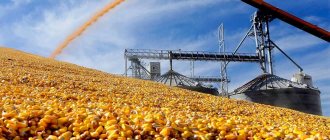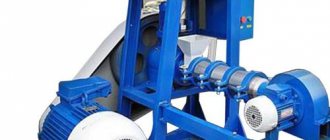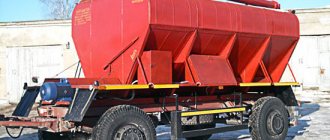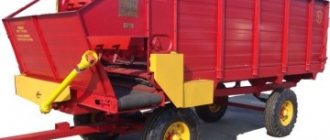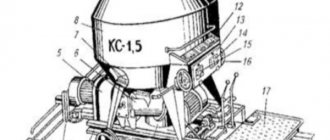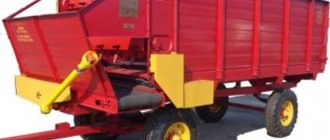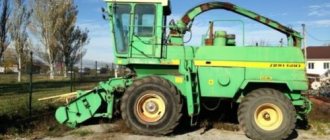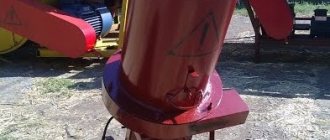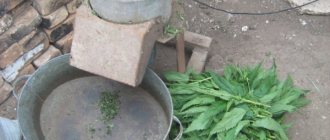Prices for extruders are the lowest in Russia at the 2022 level, KESH extruders (available in stock). Delivery to all regions! To receive an offer for extrusion lines and extruders from 500 kg/hour, please contact us. Below are the extruder models available for order.
Feed extruders make it possible to produce high-quality nutritious feed for farm animals that is most suitable for use in modern intensive livestock farming technologies. Extrudate is an environmentally friendly feed with maximum digestibility, which is produced from a variety of grain mixtures. Extrusion is a high-temperature treatment (up to 170 degrees) under high pressure (20-30 atmospheres), which results in the formation of a porous product. Under the influence of temperature and pressure during the extrusion process, carbohydrates are broken down into mono- and disaccharides, which provide a 2-3-fold increase in digestibility and improve feed performance. Our website presents various types of feed extruders for grain, soybeans, and grains. You can order and buy a mini household feed extruder on our website or in the company’s online store; sales are carried out from the dealer’s warehouse.
Extruder for feed: drawings and useful recommendations
A simple to use feed extruder makes it possible to independently produce compound feed for animals. This device is considered an indispensable assistant both in large-scale agriculture and in small farms for raising animals and birds. In specialized stores, such equipment costs decent money. To save money, you can assemble the unit yourself; drawings and recommendations from specialists will serve as an auxiliary informant in this matter.
What it is
An extruder is used to process grain crops into compound feed, which is much easier to digest in the stomach of animals. Processing is carried out using a press under a pressure of 60 atmospheres and at high temperature. The result is a product shaped like 20-30 mm corn sticks, but with a dense structure.
Apparatuses for preparing feed exist with different power ratings, and the volume of product produced depends on it. For a small farm, a device with a productivity of 25-45 kg/h is perfect - the price of such a device starts from 47 thousand rubles. But a large farm will require more powerful models capable of producing up to 1.5 tons per hour and they cost from 160 thousand rubles.
Extruder device
Due to high prices, equipment for processing products into mixed feed, even second-hand, is available to a narrow circle of consumers. But if you make an extruder for feed with your own hands, you can save a lot. Only in this case you need to study in detail the structure of the unit, the principle of operation, and also have all the necessary spare parts available.
Diagram of a large extruder
The design of the device includes the following elements:
- frame - serves as the basis, all the details are fixed on it;
- drive unit;
- belt;
- loading capacity;
- cuff;
- dosing screw with separate drive;
- gearbox;
- receiving tank;
- motor;
- injection screw conveyor;
- Control block;
- carved blade;
- washer;
- adjustment key.
Operating principle
In a homemade extruder, the main function is performed by the pressing mechanism. The element includes a discharge screw unit mounted in the cylinder. The blade block gives the product the shape of oblong sticks.
The functions of the electrical appliance are not limited to pressing feed. With its help, you can grind grain, carry out heat treatment and disinfection of feed, and mix different components into a single mass.
The design of the injection screw includes:
- outer part;
- internal;
- heating washers;
- outgoing auger.
Each unit is installed on a stud with a left-hand threaded part and covered with a housing made of metal material. Thanks to the keys, the revolutions flow from the main shaft to the combined auger. All components are firmly fixed to the frame.
Detailed extruder design (download)
The housing element is equipped with a hole, and the receiving part is mounted to it. The internal area is equipped with longitudinal grooves, due to which all feed components are mixed along the longitudinal side of the axis.
A pellet regulator is installed on the output part; its design includes:
- matrix block;
- output housing;
- blade pressed by a spring element to the matrix block.
The rotation of the shaft with the blade is carried out by means of a rein. You can monitor the temperature using a thermocouple mounted on the frame. The grain extruder operates from electrical voltage. But there are already modifications that run on fuel.
Making an extruder for feed with your own hands
If you have the necessary material, parts and tools, you can make an extruder with your own hands. Let's look at how to get a low-performance model.
To do this you will need:
- electric motor with a power of 2.2 kW at 3,000 rpm;
- gears from a tractor box - parts from YuMZ would be an excellent option;
- spring 8 mm;
- rod with a cross section of 5 cm;
- welding equipment.
Step-by-step work on making a feed extruder with your own hands:
- To obtain a cylinder, you will need to weld the tractor gears together. As a result, a spare part with a cross-section of 625 mm should be produced. Next, a spring with a diameter of 8 mm is mounted on the hydraulic cylindrical rod. Weld all the parts; if the seam is uneven, treat the area with a grinder.
- Using turning equipment, grind 2 axle boxes that will be used for the auger and gearbox. Weld the auger, shaft element and axleboxes into a single piece, and do not forget to insert a bearing between the last parts.
Blanks in the form of axle boxes
- The equipment head is mounted on the screw; it will act as a regulator of the die to which the nozzles are welded.
Workpiece on auger
- The auger is covered with a housing, all parts are assembled and fixed to the frame, an electric motor, belts and a starting part are also mounted. A loading container is installed on top.
In general terms, a homemade extruder is similar in external and functional characteristics to a household electric meat grinder.
VIDEO: Making a screw granulator with your own hands (Part 1)
How to use a homemade design
A grain granulator assembled with your own hands before large-scale production requires preliminary testing and verification work. Equipment should be tested in a safe environment.
Homemade extruder for the production of animal feed
- The first thing that needs to be checked is the quality of all connections, as well as fasteners and the maximum level of lifting to the stop.
- Then the device is fixed on a flat, stable surface. If the coating is shaky, the device may not perform its functions properly.
- Connect to a power source, start and leave for a few minutes to fully warm up the system. To prevent the elements from rotating in vain, you can check by passing a light product in the form of flour or cake from sunflower seeds through the mechanism. The correctness of the form determines whether the device has warmed up sufficiently.
When the “sausage” shape becomes smooth and dense, then the unit is ready to work with grain
- After the feed comes out in the desired shape, you can add the grain product. The supply of grain must be regular without stopping; the mechanism must not be allowed to function idle. You should also add raw materials in even portions so as not to load the system and create a jam.
- At the output, you need to adjust the feed fraction by periodically tightening the bolt and reducing the hole in the spinneret plate.
- At the end of the productive process, it is necessary to thoroughly clean the internal components from product residues. To do this, you do not need to disassemble the device; just pour the seed shells into the equipment. This raw material is capable of well collecting grain product particles due to the oils it contains.
- Reduce the rotation level to gradually cool the mechanism components. If you need to disassemble the device, you should wear heat-protective gloves, there is a risk of getting burned.
Investments in production
The cost of equipping a workshop allows you to imagine the approximate amount of investment in the production of dry food. To raise the necessary funds, you can take out a loan or try to get a grant to start a business for aspiring entrepreneurs in 2022: in any case, investors will want to find out the payback period for their investment. To do this, you need to create an economic model of the enterprise:
Investments in feed production
| Article | Amount, rub. |
| Enterprise registration | 800 |
| Opening a bank account | 3000 |
| Recipe development | 200000 |
| Obtaining a certificate | 17000 |
| Technical design of the workshop | 100000 |
| Rental during equipment installation | 140000 |
| Workshop equipment | 3131500 |
| Commissioning works | 100000 |
| Connection to utility networks | 30000 |
| Connecting communication lines | 3000 |
| Corporate website of the enterprise | 30000 |
| Promotional Products | 60000 |
| Administrative expenses | 12000 |
| Raw materials for a month | 3141600 |
| Packing for a month | 107800 |
| Workwear | 10000 |
| Total: | 7086700 |
To open a workshop with a capacity of 88 tons of dry food per month, about seven million rubles will be needed. An entrepreneur who does not have the opportunity to find such capital should think about what kind of business he can open in the garage at home with minimal investment.
Also, a fairly impressive amount will have to be allocated monthly to cover all production and non-production costs of the enterprise:
Current expenses
| Article | Amount, rub. |
| Rent | 70000 |
| Payroll | 456300 |
| Insurance premiums for individual entrepreneurs | 2700 |
| Bank account maintenance | 2200 |
| Electricity | 85000 |
| Public utilities | 5000 |
| Administrative expenses | 12000 |
| Internet and communications | 5000 |
| Advertising expenses | 25000 |
| Solid waste removal | 3000 |
| Lamp recycling | 200 |
| Alarm system maintenance | 800 |
| Ventilation maintenance | 1000 |
| Deratization and disinfestation | 7000 |
| fuels and lubricants | 15000 |
| Package | 107800 |
| Raw materials | 3141600 |
| Total: | 3939600 |
Extruder. Types and device. Operation and application. Peculiarities
An extruder is a machine for the production of long products from plastic or bulk substances. The device forces the loaded materials through a thin hole under high pressure, sometimes with preheating, which causes the substance to compact. Such machines are widely used in various fields of production.
Where is the extruder used?
Extruders have found wide application in various branches of modern industry. They are used for the production of:
- Animal feed.
- Chocolate bars.
- Pasta products.
- Wires for 3D printers.
- Plastic pipes.
- Profiles made of polyvinyl chloride.
- Polyethylene film.
- Fuel briquettes.
Extruder-type equipment is found everywhere. The production of granulated animal feed, as well as pasta, long hollow plastic products, etc. could not be done without it. The systems used for certain purposes have slight differences in technical terms, but work on the same principle.
Types of extruders based on operating principle
Based on their operating principle, extruders are divided into 3 types:
- Screw.
- Plunger
- Flat-slit.
Screw
extruder is the most common. It works on the principle of a meat grinder. Inside the device there is a rotating screw with a spiral that grabs the loaded material and pushes it through a thin hole. As a result, the mass becomes compacted and becomes hard. The pressure created raises the temperature of the raw material, which increases the efficiency of welding components. These types are the cheapest compared to others. In addition to the single screw design, twin screw extruders are also available. They create even more efficient compression, but are also more expensive. Such devices are usually used for the production of feed, as well as various food industry products.
Plunger
extruders, unlike screw extruders, accurately dose the material before giving it a specific shape. Similar devices are used for processing rubber or plastic.
Flat slot
extruders are designed for the production of rolled products such as stretch film, greenhouse film, plastic and propylene sheets. In them, the heated and viscous material is squeezed out through a flat, wide slot and quickly cools, as a result of which it retains its shape. The material is supplied using a hydraulic press, auger, or other mechanism.
Feed extruders
Feed extruders are usually represented by equipment with a screw design. They are designed for processing grain crops and herbaceous plants into compound feed. There are two types of such systems. The first simply carries out extrusion, giving a long tube at the output, and the second creates finished granules.
Conventional extruders
Conventional extrusion processes whole grains into a long, crisp tube that can be crushed into flakes. Such feed is more acceptable than raw materials loaded for processing. The fact is that as a result of compression, the mass is heated. This helps to destroy the vast majority of microorganisms that can cause eating disorders. In addition, the nutrients are baked as if in an oven, which improves their absorption by the animal’s body.
In fact, thanks to extrusion, it is possible to achieve higher animal growth rates using the same volume of feed. Such equipment also has a drawback. The resulting tube often needs to be broken into flakes by hand. There is also difficulty in measuring portions. Depending on how large the flakes are, the actual weight of the product in a given volume may vary. In this regard, when measuring a portion for feeding, it is customary to weigh it rather than use measuring containers.
Granulator extruders
An extruder operating on the principle of a granulator is less effective in terms of disinfecting the loaded mass. The output is small granules that have high hardness. They are not as fragile as the food tubes of a regular extruder. In order to improve product quality, processing is often carried out using two extrusion methods at once. First, flakes are formed, which are effectively fried, after which a granulator extruder is used.
Such equipment works on the principle of a meat grinder. Rods of feed are squeezed out through the mold and cut with a rotating knife. Thanks to this, granules that are completely identical to each other are obtained. When using a granular extruder, it is not whole grain that is loaded, but previously ground mixtures. They often contain grains, vitamins, microelements, grass flour, as well as dry meat when it comes to food for dogs, cats or other carnivores.
Extruders for the food industry
Extruders are especially popular in the food industry. Similar devices are used to form various products. They work not only with dry substances, but also with wet ones. For example, products such as crab or fish sticks are made using such equipment. The loaded mass is compacted and squeezed out. Such devices often operate without heating, simply compacting the cold mass. Many bars and candies are also made using this principle. The extruded blanks are subsequently doused with hot chocolate, making the rough extruder molding invisible.
One of the oldest extruders that are used in the food industry are pasta molding machines. They also work on the screw principle. Their design is practically no different from a feed extruder. However, there is one important difference. It is not dry mass that is loaded into them, but finished dough from durum wheat. The dough, previously prepared and well rolled using rollers to a homogeneous substance, is pressed through the molding head, resulting in pasta. Next, the rotating knife cuts them at the same distance, after which the finished pasta falls onto the conveyor belt.
Pharmacological equipment
Extruders have also found their application in pharmacology. Many tablets, as well as Hematogen bars, are made using such equipment. In pharmacology, where dosage is very important, plunger rather than screw units are often used. They make it possible to ensure with high precision that each tablet fully corresponds to the required weight, since even a hundredth of a milligram of the active substance can be of great importance in treatment.
Extruders for the production of polymer products
The extruder has become a godsend for industrial enterprises that produce polymer products. The cost of using this equipment is as profitable as possible. It costs less than installations operating according to other principles, and in addition they provide quite high-quality results. Extruders have found their application in a wide variety of polymer processing areas.
Service staff
The process of creating a production facility with a full-fledged technological line is significantly different from organizing a small business in a garage in 2022: an entrepreneur will need a whole team of specialists to perform basic and auxiliary operations. These include:
- Technologist. Must understand the methods of preparation and processing of raw materials, be able to choose the optimal operating modes of machines and mechanisms;
- Operators. The main requirements for employees are responsibility, diligence, experience in servicing equipment for the production of dog food;
- Support staff. The enterprise will not be able to function without loaders, auxiliary workers, a storekeeper, and a forwarding driver;
- Sales representatives. Conduct negotiations with wholesale buyers, conclude cooperation agreements, and collect applications. Work experience - from two years;
- Application acceptance operator. Receives orders from sales representatives, generates invoices and transfers them to the warehouse for assembly;
- Purchasing Manager. Looks for suppliers with the best conditions, ensures an uninterrupted supply of raw materials for production.
At the initial stage, the workshop will operate on a five-day schedule in one shift. As sales volumes increase, you may want to think about hiring additional employees and switching to a two-shift system.
Enterprise employees
| Position | Rate, rub. | Qty | Amount, rub. |
| Feed production technologist | 28000 | 1 | 28000 |
| Line Operator | 23000 | 5 | 115000 |
| Helper worker | 18000 | 3 | 54000 |
| Storekeeper | 20000 | 1 | 20000 |
| Delivery driver | 23000 | 1 | 23000 |
| Application acceptance operator | 18000 | 1 | 18000 |
| Purchasing Manager | 20000 | 1 | 20000 |
| Sales Representative | 25000 | 2 | 50000 |
| Accountant | 23000 | 1 | 23000 |
| Payroll tax | – | – | 105300 |
| Total: | 16 | 456300 | |
Benefits of using a grain extruder
A grain extruder is one of the most significant devices for improving the quality of grains. The need to purchase it is justified by many factors. The extruder allows you to increase the quality characteristics of grains several times. Feed processed with an extruder is more economical, easier to digest and completely safe.
This technology is used both in agriculture, helping to significantly reduce feed consumption, and in the food industry to improve the quality of the final product.
Extrusion is by far the most effective way to increase the nutritional value of grains!
Description
Grain extruders are intended for the rapid production of feed, the digestibility of which is 90-95%, while the digestibility of unprocessed grain does not exceed 65%.
As a result of a short-term increase in temperature, as well as mechanical stress and artificial pressure changes, structural and chemical changes occur in the grain .
Starch, which makes up 50% of grains and is quite difficult for animals to digest, and grain protein acquire a structure that is more easily accepted by the body.
Starch is broken down into simple sugars, complex proteins and carbohydrates are broken down into simple sugars, and fiber is converted into secondary sugars. Since the temperature effect lasts only a few seconds, beneficial vitamins and minerals are completely preserved, and fungi, pests and bacteria die.
During processing, the grain seems to explode from the inside, becoming more airy and acquiring the necessary plasticity and porosity. The volume of processed grain increases by approximately 15-20% compared to the original.
Even grains affected by insects, fungi or mold are suitable for the production of animal feed using extrusion.
After processing, feed is much easier to accept by the body, since most of the work of the stomach has already been done by the apparatus. Thanks to this, the animal spends 2 times less energy on food processing. As a result, with the same volume of fed feed, weight gain increases to 40%, milk yield to 35%, and egg production of poultry to 30%.
Documenting
Like any other business ideas in 2022 for the production of new products, manufacturing and sale of goods, the organization of manufacturing food for cats and dogs requires state registration.
For small enterprises, an individual entrepreneur is suitable. However, if an entrepreneur intends to work at the federal level or expects to attract investors, it is better to immediately register an LLC. In both cases, the OKVED code 10.92 “Production of ready-made food for pets” is selected. In addition, when using his own recipes, a businessman must develop and register with the Standardization Committee a regulatory and technical document regulating the requirements for raw materials and describing all stages of the production of food for cats and dogs. The basis for such specifications is the same GOST R 55453-2013.
Finally, to confirm that the finished product meets quality and safety standards, the manufacturer will have to obtain official evidence - a certificate or declaration. These documents are of equal force, and therefore the entrepreneur has the right to choose any of them.
Extruder operating principle
After the grain is fed into the bunker, the processes inside the apparatus take place without outside interference. Using vibration, the material is fed into the working area of the unit, where it is subjected to three-phase processing.
The processed material does not need to be steamed or subjected to any additional processing!
After entering the extruder, the grain undergoes heat treatment at temperatures from 110 to 160 degrees under pressure up to 40 atmospheres. When grain is released from this compartment, the pressure drops sharply, the water contained in the cells turns into steam and increases in volume 1000 times. As a result, an explosion occurs inside the grain, due to which it swells, acquires a porous structure, increases in volume and is better moldable.
After pressing through the profiling tool, a swollen strand emerges from the extruder, having the shape of a rope. If there is a cutter, the fraction size is approximately 10-50 mm.
The extrusion process occurs in approximately 30 seconds, which ensures high productivity with minimal energy consumption. Heating and compression of grain takes place without heating elements and hydraulics, only due to an electric motor.
Three extrusion methods are used:
- Cold forming;
- Warm processing;
- Hot extrusion.
No foundation is needed to install the extruder. It can be installed on any flat surface, even dirt floors!
Usage
Extruders are used to make animal feed.
The use of this technology can significantly reduce the cost of feeding animals. In addition, when animals are switched to feeding on extruded feed, the mortality of young animals is reduced. Feed made using extruders has the ability to prevent gastrointestinal diseases in animals and significantly improve the digestive process!
Extruders are also used in the food industry. They are used to make breakfast cereals, corn sticks, chips, crackers, baby food, and diet bread.
Twin-screw extruders are also used in the production of polymers: films for bags, polystyrene and polypropylene.
However, the most common use of an extruder is to improve the feeding qualities of grain crops. Any cereal crops, soybeans, and legumes can be used as materials for making feed.
After processing, the taste of grains is significantly improved due to the release of oils. The food acquires a pleasant aroma and bready taste. At the same time, animals eat faster.
Certain models of extruders allow you to process waste from meat and fish production. Extruders are also used to process oil-containing products before pressing. This process facilitates extraction and increases the final volume of oils obtained.
Extruder E-500
The device is intended for the production of animal feed and cleaning grains from harmful microorganisms. Also used for preparing soybeans, rapeseed, sunflower for oil extraction.
Using the device, you can process wheat, rye, corn, barley, peas, amaranth, lupine, soybeans and sunflower. A magnetic catcher of metal particles is installed in the extruder funnel, which avoids unnecessary impurities from entering the apparatus and, subsequently, into the feed.
Soybean processing capacity reaches 500 kg. per hour, when processing grains up to 300 kg. at one o'clock. In this case, the power consumption is 55 kW/hour.
- Length - 230 cm;
- Width - 210 cm;
- Height - 170 cm;
- Weight - 1400 kg.
Extruders for preparing food (the scam of our time).
More and more often I see people recommending extruders for preparing food. Pigs are growing by leaps and bounds and there is almost no manure. I don’t understand whether this is self-hypnosis, or whether these people are simply somehow connected with the manufacturers of this equipment. I also don’t understand the advertising of this equipment, because it is more than useless in pig farming, and indeed in any livestock farming.
Advertising.
What is an extruder according to the manufacturer.
This is unique equipment that prepares food. This miracle device is capable of improving the absorption of feed by pigs by up to 90-95%. THOSE. Only 5% of the fed feed goes into waste (manure). They fed a ton of feed, but only shoveled out 50 kilograms of manure.
I think everyone, even those who suffer from self-hypnosis and use this device, have already realized that this is impossible and far from reality. True, the food is actually better absorbed. True, only fast carbohydrates will turn into fat, but proteins, which are so necessary for building muscle mass, will be thermally processed. I think everyone knows what happens to proteins during heat treatment.
Introduction
For a long time, extruder manufacturers have been arguing with granulator manufacturers and each praises their equipment, some shout that theirs is more reliable, others counter that if yours produced so many tons, it would not hold up. In general, this topic is quite serious, and I really don’t want to offend anyone today. Therefore, today we will first understand how a granulator differs from a screw press, and then we will draw conclusions about what is better and for whom.
From experience we can say that no matter how much you look at it, one equipment is always better for some cases, and another for others.
